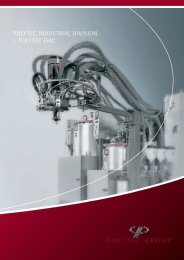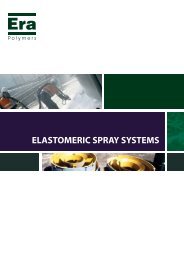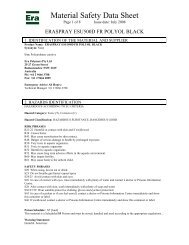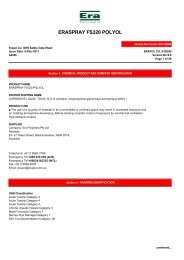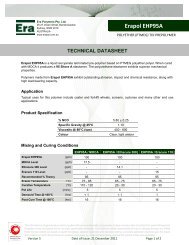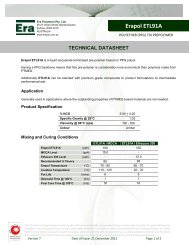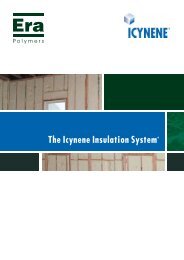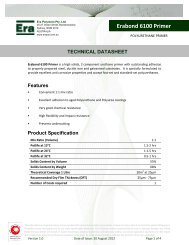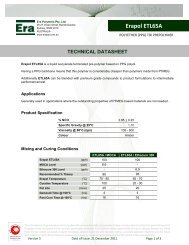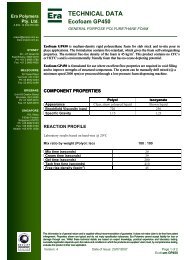eraspray es900pw part a - Era Polymers
eraspray es900pw part a - Era Polymers
eraspray es900pw part a - Era Polymers
Create successful ePaper yourself
Turn your PDF publications into a flip-book with our unique Google optimized e-Paper software.
ERASPRAY ES900PW PART AHazard Alert Code: MODERATE<strong>Era</strong>pol Co. Material Safety Data Sheet (REVIEW)Issue Date: 16-Aug-2012 ERAPOL CO. 9-38378A317LVersion No:1Page 1 of 21Section 1 - CHEMICAL PRODUCT AND COMPANY IDENTIFICATIONPRODUCT NAMEERASPRAY ES900PW PART APRODUCT USEUsed according to manufacturer's directions.Polyurethane prepolymerSUPPLIERCompany: <strong>Era</strong> <strong>Polymers</strong> Pty LtdAddress:25- 27 Green Street, Banksmeadow, NSW 2019,AustraliaTelephone: +61 2 9666 3788Emergency Tel:1800 039 008 (AUS)Emergency Tel:+80024362255 (INTL)Fax: +61 2 9666 4805Email: erapol@erapol.com.auSection 2 - HAZARDS IDENTIFICATIONSTATEMENT OF HAZARDOUS NATUREHAZARDOUS SUBSTANCE. NON-DANGEROUS GOODS. According to the Criteria of NOHSC, and the ADGCode.CONSIDERED A DANGEROUS MIXTURE ACCORDING TO DIRECTIVE 1999/45/EC AND ITS AMENDMENTS.CONSIDERED A HAZARDOUS SUBSTANCE ACCORDING TO OSHA 29 CFR 1910.1200.RISK■ Harmful by inhalation.SAFETY• Do not breathe gas/fumes/vapour/spray.continued...
ERASPRAY ES900PW PART AHazard Alert Code: MODERATE<strong>Era</strong>pol Co. Material Safety Data Sheet (REVIEW)Issue Date: 16-Aug-2012 ERAPOL CO. 9-38378A317LVersion No:1Page 2 of 21Section 2 - HAZARDS IDENTIFICATION■ Irritating to eyes, respiratory system andskin.■ Limited evidence of a carcinogenic effect.■ May cause SENSITISATION by inhalation andskin contact.■ Harmful: danger of serious damage tohealth by prolonged exposure throughinhalation.• Avoid contact with skin.• Avoid contact with eyes.• Wear suitable protective clothing.• Wear suitable gloves.• Wear eye/face protection.• Use only in well ventilated areas.• Keep container in a well ventilated place.• To clean the floor and all objects contaminated bythis material, use water and detergent.• Keep container tightly closed.• Keep away from food, drink and animal feedingstuffs.• In case of contact with eyes, rinse with plenty ofwater and contact Doctor or Poisons InformationCentre.• If swallowed, IMMEDIATELY contact Doctor orPoisons Information Centre. (show this container orlabel).• In case of accident by inhalation: remove casualtyto fresh air and keep at rest.Section 3 - COMPOSITION / INFORMATION ON INGREDIENTSNAME CAS RN %Polyurethane prepolymer >604, 4' - diphenylmethane diisocyanate (MDI) 101-68-8 30-40Section 4 - FIRST AID MEASURESSWALLOWED• Immediately give a glass of water.• First aid is not generally required. If in doubt, contact a Poisons Information Centre or a doctor.EYE■ If this product comes in contact with the eyes:• Wash out immediately with fresh running water.• Ensure complete irrigation of the eye by keeping eyelids a<strong>part</strong> and away from eye and moving the eyelids byoccasionally lifting the upper and lower lids.• Seek medical attention without delay; if pain persists or recurs seek medical attention.• Removal of contact lenses after an eye injury should only be undertaken by skilled personnel.SKIN■ If skin contact occurs:• Immediately remove all contaminated clothing, including footwear.• Flush skin and hair with running water (and soap if available).continued...
ERASPRAY ES900PW PART AHazard Alert Code: MODERATE<strong>Era</strong>pol Co. Material Safety Data Sheet (REVIEW)Issue Date: 16-Aug-2012 ERAPOL CO. 9-38378A317LVersion No:1Page 3 of 21Section 4 - FIRST AID MEASURES• Seek medical attention in event of irritation.INHALED• If fumes or combustion products are inhaled remove from contaminated area.• Lay patient down. Keep warm and rested.• Prostheses such as false teeth, which may block airway, should be removed, where possible, prior toinitiating first aid procedures.• Apply artificial respiration if not breathing, preferably with a demand valve resuscitator, bag-valve maskdevice, or pocket mask as trained. Perform CPR if necessary.• Transport to hospital, or doctor, without delay.Following uptake by inhalation, move person to an area free from risk of further exposure. Oxygen orartificial respiration should be administered as needed. Asthmatic-type symptoms may develop and may beimmediate or delayed up to several hours. Treatment is essentially symptomatic. A physician should beconsulted.NOTES TO PHYSICIANTreat symptomatically.For sub-chronic and chronic exposures to isocyanates:• This material may be a potent pulmonary sensitiser which causes bronchospasm even in patients without priorairway hyperreactivity.• Clinical symptoms of exposure involve mucosal irritation of respiratory and gastrointestinal tracts.• Conjunctival irritation, skin inflammation (erythema, pain vesiculation) and gastrointestinal disturbancesoccur soon after exposure.• Pulmonary symptoms include cough, burning, substernal pain and dyspnoea.• Some cross-sensitivity occurs between different isocyanates.• Noncardiogenic pulmonary oedema and bronchospasm are the most serious consequences of exposure. Markedlysymptomatic patients should receive oxygen, ventilatory support and an intravenous line.• Treatment for asthma includes inhaled sympathomimetics (epinephrine [adrenalin], terbutaline) and steroids.• Activated charcoal (1 g/kg) and a cathartic (sorbitol, magnesium citrate) may be useful for ingestion.• Mydriatics, systemic analgesics and topical antibiotics (Sulamyd) may be used for corneal abrasions.• There is no effective therapy for sensitised workers. [Ellenhorn and Barceloux; Medical Toxicology]NOTE: Isocyanates cause airway restriction in naive individuals with the degree of response dependant on theconcentration and duration of exposure. They induce smooth muscle contraction which leads tobronchoconstrictive episodes. Acute changes in lung function, such as decreased FEV1, may not representsensitivity.[Karol & Jin, Frontiers in Molecular Toxicology, pp 56-61, 1992]Personnel who work with isocyanates, isocyanate prepolymers or polyisocyanates should have a pre-placementmedical examination and periodic examinations thereafter, including a pulmonary function test. Anyone with amedical history of chronic respiratory disease, asthmatic or bronchial attacks, indications of allergicresponses, recurrent eczema or sensitisation conditions of the skin should not handle or work withisocyanates. Anyone who develops chronic respiratory distress when working with isocyanates should be removedfrom exposure and examined by a physician. Further exposure must be avoided if a sensitivity to isocyanatesor polyisocyanates has developed.Section 5 - FIRE FIGHTING MEASURESEXTINGUISHING MEDIA• Flooding quantities of water only.• Foam.• Dry chemical powder.• BCF (where regulations permit).• Carbon dioxide.continued...
ERASPRAY ES900PW PART AHazard Alert Code: MODERATE<strong>Era</strong>pol Co. Material Safety Data Sheet (REVIEW)Issue Date: 16-Aug-2012 ERAPOL CO. 9-38378A317LVersion No:1Page 4 of 21Section 5 - FIRE FIGHTING MEASURES• Water spray or fog - Large fires only.FIRE FIGHTING• Alert Fire Brigade and tell them location and nature of hazard.• Wear full body protective clothing with breathing apparatus.• Prevent, by any means available, spillage from entering drains or water course.• Use water delivered as a fine spray to control fire and cool adjacent area.• Avoid spraying water onto liquid pools.• DO NOT approach containers suspected to be hot.• Cool fire exposed containers with water spray from a protected location.• If safe to do so, remove containers from path of fire.FIRE/EXPLOSION HAZARD• Combustible.• Moderate fire hazard when exposed to heat or flame.• When heated to high temperatures decomposes rapidly generating vapour which pressures and may then rupturecontainers with release of flammable and highly toxic isocyanate vapour.• Burns with acrid black smoke and poisonous fumes.• Combustion yields traces of highly toxic hydrogen cyanide HCN, plus toxic nitrogen oxides NOx and carbonmonoxide.Combustion products include: carbon dioxide (CO2), isocyanates, and minor amounts of, hydrogen cyanide,nitrogen oxides (NOx), other pyrolysis products typical of burning organic material.May emit corrosive fumes.FIRE INCOMPATIBILITY• Avoid contamination with oxidising agents i.e. nitrates, oxidising acids, chlorine bleaches, pool chlorineetc. as ignition may result.HAZCHEMNoneSection 6 - ACCIDENTAL RELEASE MEASURESMINOR SPILLS• Remove all ignition sources.• Clean up all spills immediately.• Avoid breathing vapours and contact with skin and eyes.• Control personal contact with the substance, by using protective equipment.• Contain and absorb spill with sand, earth, inert material or vermiculite.• Wipe up.• Place in a suitable, labelled container for waste disposal.MAJOR SPILLSChemical Class: cyanates and isocyanatesFor release onto land: recommended sorbents listed in order of priority.SORBENT TYPE RANK APPLICATION COLLECTION LIMITATIONSLAND SPILL - SMALLcontinued...
ERASPRAY ES900PW PART AHazard Alert Code: MODERATE<strong>Era</strong>pol Co. Material Safety Data Sheet (REVIEW)Issue Date: 16-Aug-2012 ERAPOL CO. 9-38378A317LVersion No:1Page 5 of 21Section 6 - ACCIDENTAL RELEASE MEASUREScross- linked 1 shovel shovel R, W, SSpolymer -<strong>part</strong>iculatewood fiber - 1 throw pitchfork R, P, DGC, RT<strong>part</strong>iculatecross- linked 1 throw pitchfork R, DGC, RTpolymer - pillowsorbent clay - 2 shovel shovel R, I, P<strong>part</strong>iculatefoamed glass - 2 throw pitchfork R, P, DGC, RTpillowwood fiber - 3 shovel shovel R, W, P, DGC<strong>part</strong>iculateLAND SPILL - MEDIUMcross- linked 1 blower skiploader R, W, SSpolymer -<strong>part</strong>iculatecross- linked 1 throw skiploader R, DGC, RTpolymer - pillowpolypropylene - 2 blower skiploader R, SS, DGC<strong>part</strong>iculateexpanded mineral - 3 blower skiploader R, I, W, P, DGC<strong>part</strong>iculatewood fiber - 3 blower skiploader R, W, P, DGC<strong>part</strong>iculatepolypropylene - mat 3 throw skiploader DGC, RTLegendDGC: Not effective where ground cover is denseR; Not reusableI: Not incinerableP: Effectiveness reduced when rainyRT:Not effective where terrain is ruggedSS: Not for use within environmentally sensitive sitesW: Effectiveness reduced when windyReference: Sorbents for Liquid Hazardous Substance Cleanup and Control;R.W Melvold et al: Pollution Technology Review No. 150: Noyes Data Corporation 1988.For isocyanate spills of less than 40 litres (2 m2):• Evacuate area from everybody not dealing with the emergency, keep them upwind and prevent further access,remove ignition sources and, if inside building, ventilate area as well as possible.• Notify supervision and others as necessary.• Put on personal protective equipment (suitable respiratory protection, face and eye protection, protectivesuit, gloves and impermeable boots).• Control source of leakage (where applicable).• Dike the spill to prevent spreading and to contain additions of decontaminating solution.• Prevent the material from entering drains.• Estimate spill pool volume or area.• Absorb and decontaminate. - Completely cover the spill with wet sand, wet earth, vermiculite or othersimilar absorbent. - Add neutraliser (for suitable formulations: see below) to the adsorbent materials(equal to that of estimated spill pool volume). Intensify contact between spill, absorbent and neutraliserby carefully mixing with a rake and allow to react for 15 minutes• Shovel absorbent/decontaminant solution mixture into a steel drum.continued...
ERASPRAY ES900PW PART AHazard Alert Code: MODERATE<strong>Era</strong>pol Co. Material Safety Data Sheet (REVIEW)Issue Date: 16-Aug-2012 ERAPOL CO. 9-38378A317LVersion No:1Page 6 of 21Section 6 - ACCIDENTAL RELEASE MEASURES• Decontaminate surface. - Pour an equal amount of neutraliser solution over contaminated surface. - Scrubarea with a stiff bristle brush, using moderate pressure. - Completely cover decontaminant with vermiculiteor other similar absorbent. - After 5 minutes, shovel absorbent/decontamination solution mixture into thesame steel drum used above.• Monitor for residual isocyanate. If surface is decontaminated, proceed to next step. If contaminationpersists, repeat decontaminate procedure immediately above• Place loosely covered drum (release of carbon dioxide) outside for at least 72 hours. Label wastecontainingdrum appropriately. Remove waste materials for incineration.• Decontaminate and remove personal protective equipment.• Return to normal operation.• Conduct accident investigation and consider measures to prevent reoccurrence.Decontamination:Treat isocyanate spills with sufficient amounts of isocyanate decontaminant preparation ("neutralisingfluid"). Isocyanates and polyisocyanates are generally not miscible with water. Liquid surfactants arenecessary to allow better dispersion of isocyanate and neutralising fluids/ preparations. Alkalineneutralisers react faster than water/surfactant mixtures alone.Typically, such a preparation may consist of:Sawdust: 20 <strong>part</strong>s by weight Kieselguhr 40 <strong>part</strong>s by weight plus a mixture of {ammonia (s.g. 0.880) 8% v/v nonionicsurfactant 2% v/v water 90% v/v}.Let stand for 24 hoursThree commonly used neutralising fluids each exhibit advantages in different situations.Formulation A :liquid surfactant 0.2-2%sodium carbonate 5-10%water to 100%Formulation Bliquid surfactant 0.2-2%concentrated ammonia 3-8%water to 100%Formulation Cethanol, isopropanol or butanol 50%concentrated ammonia 5%water to 100%After application of any of these formulae, let stand for 24 hours.Formulation B reacts faster than Formulation A. However, ammonia-based neutralisers should be used only underwell-ventilated conditions to avoid overexposure to ammonia or if members of the emergency team wear suitablerespiratory protection. Formulation C is especially suitable for cleaning of equipment from unreactedisocyanate and neutralizing under freezing conditions. Regard has to be taken to the flammability of thealcoholic solution.• Avoid contamination with water, alkalies and detergent solutions.• Material reacts with water and generates gas, pressurises containers with even drum rupture resulting.• DO NOT reseal container if contamination is suspected.• Open all containers with care.Moderate hazard.• Clear area of personnel and move upwind.• Alert Fire Brigade and tell them location and nature of hazard.• Wear breathing apparatus plus protective gloves.• Prevent, by any means available, spillage from entering drains or water course.• No smoking, naked lights or ignition sources.• Increase ventilation.• Stop leak if safe to do so.continued...
ERASPRAY ES900PW PART AHazard Alert Code: MODERATE<strong>Era</strong>pol Co. Material Safety Data Sheet (REVIEW)Issue Date: 16-Aug-2012 ERAPOL CO. 9-38378A317LVersion No:1Page 7 of 21Section 6 - ACCIDENTAL RELEASE MEASURES• Contain spill with sand, earth or vermiculite.• Collect recoverable product into labelled containers for recycling.• Absorb remaining product with sand, earth or vermiculite.• Collect solid residues and seal in labelled drums for disposal.• Wash area and prevent runoff into drains.• If contamination of drains or waterways occurs, advise emergency services.PROTECTIVE ACTIONS FOR SPILLFrom US Emergency Response Guide 2000GuideSMALL SPILLSName Isolation Distance Downwind Day Protection Nightft ( m) mile ( km) mile ( km)LARGE SPILLSName Isolation Distance Downwind Day Protection Nightft ( m) mile ( km) mile ( km)From IERG (Canada/Australia)Isolation Distance -Downwind Protection Distance -IERG NumberNoneFOOTNOTES1 PROTECTIVE ACTION ZONE is defined as the area in which people are at risk of harmful exposure. This zoneassumes that random changes in wind direction confines the vapour plume to an area within 30 degrees oneither side of the predominant wind direction, resulting in a crosswind protective action distance equal tothe downwind protective action distance.2 PROTECTIVE ACTIONS should be initiated to the extent possible, beginning with those closest to the spilland working away from the site in the downwind direction. Within the protective action zone a level of vapourconcentration may exist resulting in nearly all unprotected persons becoming incapacitated and unable to takeprotective action and/or incurring serious or irreversible health effects.3 INITIAL ISOLATION ZONE is determined as an area, including upwind of the incident, within which a highprobability of localised wind reversal may expose nearly all persons without appropriate protection to lifethreateningconcentrations of the material.4 SMALL SPILLS involve a leaking package of 200 litres (55 US gallons) or less, such as a drum (jerrican orbox with inner containers). Larger packages leaking less than 200 litres and compressed gas leaking from asmall cylinder are also considered "small spills".LARGE SPILLS involve many small leaking packages or a leaking package of greater than 200 litres, such ascontinued...
ERASPRAY ES900PW PART AHazard Alert Code: MODERATE<strong>Era</strong>pol Co. Material Safety Data Sheet (REVIEW)Issue Date: 16-Aug-2012 ERAPOL CO. 9-38378A317LVersion No:1Page 8 of 21Section 6 - ACCIDENTAL RELEASE MEASURESa cargo tank, portable tank or a "one-tonne" compressed gas cylinder.5 Guide is taken from the US DOT emergency response guide book.6 IERG information is derived from CANUTEC - Transport Canada.EMERGENCY RESPONSE PLANNING GUIDELINES (ERPG)The maximum airborne concentration below which it is believed that nearly all individuals could be exposedfor up to one hour WITHOUT experiencing or developinglife-threatening health effects is:4,4'-diphenylmethane diisocyanate (MDI)55 mg/m³irreversible or other serious effects or symptoms which could impair an individual's ability to takeprotective action is:4,4'-diphenylmethane diisocyanate (MDI)5 mg/m³other than mild, transient adverse effects without perceiving a clearly defined odour is:4,4'-diphenylmethane diisocyanate (MDI)NA†American Industrial Hygiene Association (AIHA)Ingredients considered according to the following cutoffsVery Toxic (T+) >= 0.1% Toxic (T) >= 3.0%R50 >= 0.25% Corrosive (C) >= 5.0%R51 >= 2.5%else >= 10%where percentage is percentage of ingredient found in the mixturePersonal Protective Equipment advice is contained in Section 8 of the MSDS.Section 7 - HANDLING AND STORAGEPROCEDURE FOR HANDLING• DO NOT allow clothing wet with material to stay in contact with skin.• Avoid all personal contact, including inhalation.• Wear protective clothing when risk of exposure occurs.• Use in a well-ventilated area.• Prevent concentration in hollows and sumps.• DO NOT enter confined spaces until atmosphere has been checked.• Avoid smoking, naked lights or ignition sources.• Avoid contact with incompatible materials.• When handling, DO NOT eat, drink or smoke.• Keep containers securely sealed when not in use.• Avoid physical damage to containers.• Always wash hands with soap and water after handling.• Work clothes should be laundered separately.• Use good occupational work practice.• Observe manufacturer's storage and handling recommendations contained within this MSDS.• Atmosphere should be regularly checked against established exposure standards to ensure safe workingconditions.continued...
ERASPRAY ES900PW PART AHazard Alert Code: MODERATE<strong>Era</strong>pol Co. Material Safety Data Sheet (REVIEW)Issue Date: 16-Aug-2012 ERAPOL CO. 9-38378A317LVersion No:1Page 9 of 21Section 7 - HANDLING AND STORAGESUITABLE CONTAINER• Metal can or drum• Packaging as recommended by manufacturer.• Check all containers are clearly labelled and free from leaks.STORAGE INCOMPATIBILITY• Avoid reaction with water, alcohols and detergent solutions.• Isocyanates and thioisocyanates are incompatible with many classes of compounds, reacting exothermically torelease toxic gases. Reactions with amines, strong bases, aldehydes, alcohols, alkali metals, ketones,mercaptans, strong oxidisers, hydrides, phenols, and peroxides can cause vigorous releases of heat. Acidsand bases initiate polymerisation reactions in these materials.• Isocyanates easily form adducts with carbodiimides, isothiocyanates, ketenes, or with substrates containingactivated CC or CN bonds.• Some isocyanates react with water to form amines and liberate carbon dioxide. This reaction may alsogenerate large volumes of foam and heat. Foaming in confined spaces may produce pressure in confined spacesor containers. Gas generation may pressurise drums to the point of rupture.• Do NOT reseal container if contamination is expected• Open all containers with care• Base-catalysed reactions of isocyanates with alcohols should be carried out in inert solvents. Suchreactions in the absence of solvents often occur with explosive violence,• Isocyanates will attack and embrittle some plastics and rubbers.• A range of exothermic decomposition energies for isocyanates is given as 20-30 kJ/mol.• The relationship between energy of decomposition and processing hazards has been the subject of discussion;it is suggested that values of energy released per unit of mass, rather than on a molar basis (J/g) be usedin the assessment.• For example, in "open vessel processes" (with man-hole size openings, in an industrial setting), substanceswith exothermic decomposition energies below 500 J/g are unlikely to present a danger, whilst those in"closed vessel processes" (opening is a safety valve or bursting disk) present some danger where thedecomposition energy exceeds 150 J/g.BRETHERICK: Handbook of Reactive Chemical Hazards, 4th Edition.STORAGE REQUIREMENTSfor commercial quantities of isocyanates:• Isocyanates should be stored in adequately bunded areas. Nothing else should be kept within the samebunding. Pre-polymers need not be segregated. Drums of isocyanates should be stored under cover, out ofdirect sunlight, protected from rain, protected from physical damage and well away from moisture, acids andalkalis.• Where isocyanates are stored at elevated temperatures to prevent solidifying, adequate controls should beinstalled to prevent the high temperatures and precautions against fire should be taken.• Where stored in tanks, the more reactive isocyanates should be blanketed with a non-reactive gas such asnitrogen and equipped with absorptive type breather valve (to prevent vapour emissions)..• Transfer systems for isocyanates in bulk storage should be fully enclosed and use pump or vacuum systems.Warning signs, in appropriate languages, should be posted where necessary.• Areas in which polyurethane foam products are stored should be supplied with good general ventilation.Residual amounts of unreacted isocyanate may be present in the finished foam, resulting in hazardousatmospheric concentrations.• Store in original containers.• Keep containers securely sealed.• No smoking, naked lights or ignition sources.• Store in a cool, dry, well-ventilated area.• Store away from incompatible materials and foodstuff containers.• Protect containers against physical damage and check regularly for leaks.• Observe manufacturer's storage and handling recommendations contained within this MSDS.continued...
ERASPRAY ES900PW PART AHazard Alert Code: MODERATE<strong>Era</strong>pol Co. Material Safety Data Sheet (REVIEW)Issue Date: 16-Aug-2012 ERAPOL CO. 9-38378A317LVersion No:1Page 10 of 21Section 7 - HANDLING AND STORAGE_____________________________________________________SAFE STORAGE WITH OTHER CLASSIFIED CHEMICALS+ X + X X +_____________________________________________________+: May be stored togetherO: May be stored together with specific preventionsX: Must not be stored togetherSection 8 - EXPOSURE CONTROLS / PERSONAL PROTECTIONEXPOSURE CONTROLSSource Material TWA TWA STEL STEL Peak Peak TWA Notesppm mg/m³ ppm mg/m³ ppm mg/m³ F/CC__________ __________ ______ ______ ______ ______ ______ ______ ______ ______Australia 4, 4' - 0.02 0.07ExposurediphenylmethaneStandardsdiisocyanate(MDI)(Isocyanates,all (as- NCO))EMERGENCY EXPOSURE LIMITSMaterial Revised IDLH Value (mg/m3) Revised IDLH Value (ppm)4,4'-diphenylmethane diisocyanate (MDI)|2489 75MATERIAL DATAERASPRAY ES900PW PART A:Sensory irritants are chemicals that produce temporary and undesirable side-effects on the eyes, nose orthroat. Historically occupational exposure standards for these irritants have been based on observation ofworkers' responses to various airborne concentrations. Present day expectations require that nearly everyindividual should be protected against even minor sensory irritation and exposure standards are establishedusing uncertainty factors or safety factors of 5 to 10 or more. On occasion animal no-observable-effectlevels(NOEL) are used to determine these limits where human results are unavailable. An additional approach,typically used by the TLV committee (USA) in determining respiratory standards for this group of chemicals,has been to assign ceiling values (TLV C) to rapidly acting irritants and to assign short-term exposurelimits (TLV STELs) when the weight of evidence from irritation, bioaccumulation and other endpoints combineto warrant such a limit. In contrast the MAK Commission (Germany) uses a five-category system based onintensive odour, local irritation, and elimination half-life. However this system is being replaced to beconsistent with the European Union (EU) Scientific Committee for Occupational Exposure Limits (SCOEL); thisis more closely allied to that of the USA.OSHA (USA) concluded that exposure to sensory irritants can:• cause inflammation• cause increased susceptibility to other irritants and infectious agents• lead to permanent injury or dysfunction• permit greater absorption of hazardous substances and• acclimate the worker to the irritant warning properties of these substances thus increasing the risk ofcontinued...
ERASPRAY ES900PW PART AHazard Alert Code: MODERATE<strong>Era</strong>pol Co. Material Safety Data Sheet (REVIEW)Issue Date: 16-Aug-2012 ERAPOL CO. 9-38378A317LVersion No:1Page 11 of 21Section 8 - EXPOSURE CONTROLS / PERSONAL PROTECTIONoverexposure.4,4'-DIPHENYLMETHANE DIISOCYANATE (MDI):for diphenylmethane diisocyanate (methylene bisphenyl isocyanate; MDI)Odour Threshold Value: 0.39 ppmIDLH Level: 10 mg/m3Mean MDI exposures of less than 0.003 ppm appear to have no acute or chronic effect on pulmonary function.MDI produces identical toxicological responses to those produced by TDI and the recommended TLV-TWA isidentical for the two isocyanates. Exposure at or below the recommended value is thought to protect theworker against pulmonary function decrements as well as to minimise the potential for respiratory tractsensitisation. Individuals who may be hypersusceptible or otherwise unusually responsive to exposure tocertain industrial chemicals may not adequately protected from adverse health effects caused by MDI at therecommended TLV-TWA. Ceiling values recommended by NIOSH and OSHA are synonymous with normal excursionsallowable for exposures to the TLV-TWA (in excess of 3 x TLV-TWA for no more than a total of 30 minutesduring a work day but in any case not exceeding 5 x TLV-TWA).PERSONAL PROTECTIONEYE• Safety glasses with side shields.• Chemical goggles.• Contact lenses may pose a special hazard; soft contact lenses may absorb and concentrate irritants. Awritten policy document, describing the wearing of lens or restrictions on use, should be created for eachworkplace or task. This should include a review of lens absorption and adsorption for the class ofchemicals in use and an account of injury experience. Medical and first-aid personnel should be trained intheir removal and suitable equipment should be readily available. In the event of chemical exposure, begineye irrigation immediately and remove contact lens as soon as practicable. Lens should be removed at thefirst signs of eye redness or irritation - lens should be removed in a clean environment only after workershave washed hands thoroughly. [CDC NIOSH Current Intelligence Bulletin 59], [AS/NZS 1336 or nationalequivalent].HANDS/FEET■ NOTE:• The material may produce skin sensitisation in predisposed individuals. Care must be taken, when removinggloves and other protective equipment, to avoid all possible skin contact.• Contaminated leather items, such as shoes, belts and watch-bands should be removed and destroyed.The selection of the suitable gloves does not only depend on the material, but also on further marks ofquality which vary from manufacturer to manufacturer. Where the chemical is a preparation of severalsubstances, the resistance of the glove material can not be calculated in advance and has therefore to bechecked prior to the application.The exact break through time for substances has to be obtained from the manufacturer of the protective glovesandhas to be observed when making a final choice.Suitability and durability of glove type is dependent on usage. Important factors in the selection of glovesinclude:continued...
ERASPRAY ES900PW PART AHazard Alert Code: MODERATE<strong>Era</strong>pol Co. Material Safety Data Sheet (REVIEW)Issue Date: 16-Aug-2012 ERAPOL CO. 9-38378A317LVersion No:1Page 12 of 21Section 8 - EXPOSURE CONTROLS / PERSONAL PROTECTION• frequency and duration of contact,• chemical resistance of glove material,• glove thickness and• dexteritySelect gloves tested to a relevant standard (e.g. Europe EN 374, US F739, AS/NZS 2161.1 or nationalequivalent).• When prolonged or frequently repeated contact may occur, a glove with a protection class of 5 or higher(breakthrough time greater than 240 minutes according to EN 374, AS/NZS 2161.10.1 or national equivalent)is recommended.• When only brief contact is expected, a glove with a protection class of 3 or higher (breakthrough timegreater than 60 minutes according to EN 374, AS/NZS 2161.10.1 or national equivalent) is recommended.• Contaminated gloves should be replaced.Gloves must only be worn on clean hands. After using gloves, hands should be washed and dried thoroughly.Application of a non-perfumed moisturiser is recommended.• Isocyanate resistant materials include Teflon, Viton, nitrile rubber and some PVA gloves.• Protective gloves and overalls should be worn as specified in the appropriate national standard.• Contaminated garments should be removed promptly and should not be re-used until they have beendecontaminated.• NOTE: Natural rubber, neoprene, PVC can be affected by isocyanates.OTHER• Overalls.• P.V.C. apron.• Barrier cream.• Skin cleansing cream.• Eye wash unit.RESPIRATOR•Type A Filter of sufficient capacity. (AS/NZS 1716 & 1715, EN 143:2000 & 149:2001, ANSI Z88 or nationalequivalent)■ Cartridge respirators should never be used for emergency ingress or in areas of unknown vapourconcentrations or oxygen content. The wearer must be warned to leave the contaminated area immediately ondetecting any odours through the respirator. The odour may indicate that the mask is not functioning properly,that the vapour concentration is too high, or that the mask is not properly fitted. Because of theselimitations, only restricted use of cartridge respirators is considered appropriate.• In certain circumstances, personal protection of the individual employee is necessary. Personal protectivedevices should be regarded as being supplementary to substitution and engineering control and should not beused in preference to them as they do nothing to eliminate the hazard.• However, in some situations, minimising exposure to isocyanates by enclosure and ventilation is notpossible, and occupational exposure standards may be exceeded, <strong>part</strong>icularly during on-site mixing of paints,spray-painting, foaming and maintenance of machine and ventilation systems. In these situations, air-linerespirators or self-contained breathing apparatus complying with the appropriate nationals standard must beused.• Organic vapour respirators with <strong>part</strong>iculate pre- filters and powered, air-purifying respirators are NOTsuitable.• Personal protective equipment must be appropriately selected, individually fitted and workers trained intheir correct use and maintenance. Personal protective equipment must be regularly checked and maintainedto ensure that the worker is being protected.• Air- line respirators or self-contained breathing apparatus complying with the appropriate nationalstandard should be used during the clean-up of spills and the repair or clean-up of contaminated equipmentand similar situations which cause emergency exposures to hazardous atmospheric concentrations ofisocyanate.The local concentration of material, quantity and conditions of use determine the type of personal protectivecontinued...
ERASPRAY ES900PW PART AHazard Alert Code: MODERATE<strong>Era</strong>pol Co. Material Safety Data Sheet (REVIEW)Issue Date: 16-Aug-2012 ERAPOL CO. 9-38378A317LVersion No:1Page 13 of 21Section 8 - EXPOSURE CONTROLS / PERSONAL PROTECTIONequipment required. For further information consult site specific CHEMWATCH data (if available), or yourOccupational Health and Safety Advisor.ENGINEERING CONTROLS■ Engineering controls are used to remove a hazard or place a barrier between the worker and the hazard. Welldesignedengineering controls can be highly effective in protecting workers and will typically be independentof worker interactions to provide this high level of protection.The basic types of engineering controls are:Process controls which involve changing the way a job activity or process is done to reduce the risk.Enclosure and/or isolation of emission source which keeps a selected hazard "physically" away from the workerand ventilation that strategically "adds" and "removes" air in the work environment. Ventilation can removeor dilute an air contaminant if designed properly. The design of a ventilation system must match the<strong>part</strong>icular process and chemical or contaminant in use.Employers may need to use multiple types of controls to prevent employee overexposure.• Spraying of material or material in admixture with other components must be carried out in conditionsconforming to local state regulations.• Local exhaust ventilation with full face positive-pressure air supplied breathing apparatus (hood or helmettype) is normally required.• Spraying should be performed in a spray booth fitted with an effective exhaust system which complies withlocal environmental legislation.• The spray booth area must be isolated from unprotected personnel whilst spraying is in progress and untilall spraying mist has cleared.NOTE: Isocyanate vapours will not be adequately absorbed by organic vapour respirators.Section 9 - PHYSICAL AND CHEMICAL PROPERTIESAPPEARANCEClear pale yellow liquidPHYSICAL PROPERTIESLiquid.State Liquid Molecular Weight Not AvailableMelting Range (°C) Not Available Viscosity Not AvailableBoiling Range (°C) >250 Solubility in water (g/L) Reacts with waterliberating carbondioxide [Reacts]Flash Point (°C) >150 pH (1% solution) Not AvailableDecomposition Temp (°C) Not Available pH (as supplied) Not AvailableAutoignition Temp (°C) Not Available Vapour Pressure (kPa) Not AvailableUpper Explosive Limit (%) Not Available Specific Gravity (water=1) 1.10Lower Explosive Limit (%) Not Available Relative Vapour Density Not Available(air=1)Volatile Component (%vol) Not Available Evaporation Rate Not Availablecontinued...
ERASPRAY ES900PW PART AHazard Alert Code: MODERATE<strong>Era</strong>pol Co. Material Safety Data Sheet (REVIEW)Issue Date: 16-Aug-2012 ERAPOL CO. 9-38378A317LVersion No:1Page 14 of 21Section 10 - STABILITY AND REACTIVITYCONDITIONS CONTRIBUTING TO INSTABILITY• Presence of incompatible materials.• Product is considered stable.• Hazardous polymerisation will not occur.• Presence of elevated temperatures.For incompatible materials - refer to Section 7 - Handling and Storage.Section 11 - TOXICOLOGICAL INFORMATIONPOTENTIAL HEALTH EFFECTSACUTE HEALTH EFFECTSSWALLOWED■ The material is not thought to produce adverse health effects following ingestion (as classified by ECDirectives using animal models). Nevertheless, adverse systemic effects have been produced following exposureof animals by at least one other route and good hygiene practice requires that exposure be kept to a minimum.EYE■ Evidence exists, or practical experience predicts, that the material may cause eye irritation in asubstantial number of individuals and/or may produce significant ocular lesions which are present twenty-fourhours or more after instillation into the eye(s) of experimental animals. Repeated or prolonged eye contactmay cause inflammation characterised by a temporary redness (similar to windburn) of the conjunctiva(conjunctivitis); temporary impairment of vision and/or other transient eye damage/ulceration may occur.SKIN■ Evidence exists, or practical experience predicts, that the material either produces inflammation of theskin in a substantial number of individuals following direct contact, and/or produces significantinflammation when applied to the healthy intact skin of animals, for up to four hours, such inflammationbeing present twenty-four hours or more after the end of the exposure period. Skin irritation may also bepresent after prolonged or repeated exposure; this may result in a form of contact dermatitis (nonallergic).The dermatitis is often characterised by skin redness (erythema) and swelling (oedema) which may progress toblistering (vesiculation), scaling and thickening of the epidermis. At the microscopic level there may beintercellular oedema of the spongy layer of the skin (spongiosis) and intracellular oedema of the epidermis.The material may accentuate any pre-existing dermatitis condition.Open cuts, abraded or irritated skin should not be exposed to this material.Entry into the blood-stream through, for example, cuts, abrasions, puncture wounds or lesions, may producesystemic injury with harmful effects. Examine the skin prior to the use of the material and ensure that anyexternal damage is suitably protected.INHALED■ Inhalation of aerosols (mists, fumes), generated by the material during the course of normal handling, maybe harmful.Evidence shows, or practical experience predicts, that the material produces irritation of the respiratorysystem, in a substantial number of individuals, following inhalation. In contrast to most organs, the lung isable to respond to a chemical insult by first removing or neutralising the irritant and then repairing thedamage. The repair process, which initially evolved to protect mammalian lungs from foreign matter andantigens, may however, produce further lung damage resulting in the impairment of gas exchange, the primaryfunction of the lungs. Respiratory tract irritation often results in an inflammatory response involving thecontinued...
ERASPRAY ES900PW PART AHazard Alert Code: MODERATE<strong>Era</strong>pol Co. Material Safety Data Sheet (REVIEW)Issue Date: 16-Aug-2012 ERAPOL CO. 9-38378A317LVersion No:1Page 15 of 21Section 11 - TOXICOLOGICAL INFORMATIONrecruitment and activation of many cell types, mainly derived from the vascular system.The vapour/mist may be highly irritating to the upper respiratory tract and lungs; the response may be severeenough to produce bronchitis and pulmonary oedema. Possible neurological symptoms arising from isocyanateexposure include headache, insomnia, euphoria, ataxia, anxiety neurosis, depression and paranoia.Gastrointestinal disturbances are characterised by nausea and vomiting. Pulmonary sensitisation may produceasthmatic reactions ranging from minor breathing difficulties to severe allergic attacks; this may occurfollowing a single acute exposure or may develop without warning for several hours after exposure. Sensitizedpeople can react to very low doses, and should not be allowed to work in situations allowing exposure to thismaterial. Continued exposure of sensitised persons may lead to possible long term respiratory impairment.Inhalation hazard is increased at higher temperatures.CHRONIC HEALTH EFFECTS■ On the basis, primarily, of animal experiments, concern has been expressed that the material may producecarcinogenic or mutagenic effects; in respect of the available information, however, there presently existsinadequate data for making a satisfactory assessment.Long-term exposure to respiratory irritants may result in disease of the airways involving difficultbreathing and related systemic problems.Practical evidence shows that inhalation of the material is capable of inducing a sensitisation reaction in asubstantial number of individuals at a greater frequency than would be expected from the response of a normalpopulation.Pulmonary sensitisation, resulting in hyperactive airway dysfunction and pulmonary allergy may be accompaniedby fatigue, malaise and aching. Significant symptoms of exposure may persist for extended periods, even afterexposure ceases. Symptoms can be activated by a variety of nonspecific environmental stimuli such asautomobile exhaust, perfumes and passive smoking.Practical experience shows that skin contact with the material is capable either of inducing a sensitisationreaction in a substantial number of individuals, and/or of producing a positive response in experimentalanimals.Harmful: danger of serious damage to health by prolonged exposure through inhalation.Serious damage (clear functional disturbance or morphological change which may have toxicologicalsignificance) is likely to be caused by repeated or prolonged exposure. As a rule the material produces, orcontains a substance which produces severe lesions. Such damage may become apparent following directapplication in subchronic (90 day) toxicity studies or following sub-acute (28 day) or chronic (two-year)toxicity tests.Limited evidence suggests that repeated or long-term occupational exposure may produce cumulative healtheffects involving organs or biochemical systems.Isocyanate vapours/mists are irritating to the upper respiratory tract and lungs; the response may be severeenough to produce bronchitis with wheezing, gasping and severe distress, even sudden loss of consciousness,and pulmonary oedema. Possible neurological symptoms arising from isocyanate exposure include headache,insomnia, euphoria, ataxia, anxiety neurosis, depression and paranoia. Gastrointestinal disturbances arecharacterised by nausea and vomiting. Pulmonary sensitisation may produce asthmatic reactions ranging fromminor breathing difficulties to severe allergic attacks; this may occur following a single acute exposure ormay develop without warning after a period of tolerance. A respiratory response may occur following minorskin contact. Skin sensitisation is possible and may result in allergic dermatitis responses including rash,itching, hives and swelling of extremities.Isocyanate-containing vapours/ mists may cause inflammation of eyes and nasal passages.Onset of symptoms may be immediate or delayed for several hours after exposure. Sensitised people can reactto very low levels of airborne isocyanates. Unprotected or sensitised persons should not be allowed to workin situations allowing exposure to this material.TOXICITY AND IRRITATION4,4'-DIPHENYLMETHANE DIISOCYANATE (MDI):ERASPRAY ES900PW PART A:■ for diisocyanates:In general, there appears to be little or no difference between aromatic and aliphatic diisocyanates ascontinued...
ERASPRAY ES900PW PART AHazard Alert Code: MODERATE<strong>Era</strong>pol Co. Material Safety Data Sheet (REVIEW)Issue Date: 16-Aug-2012 ERAPOL CO. 9-38378A317LVersion No:1Page 16 of 21Section 11 - TOXICOLOGICAL INFORMATIONtoxicants. In addition, there are insufficient data available to make any major distinctions betweenpolymeric (
ERASPRAY ES900PW PART AHazard Alert Code: MODERATE<strong>Era</strong>pol Co. Material Safety Data Sheet (REVIEW)Issue Date: 16-Aug-2012 ERAPOL CO. 9-38378A317LVersion No:1Page 17 of 21Section 11 - TOXICOLOGICAL INFORMATIONirritants may produce conjunctivitis.■ Exogenous allergic alveolitis is induced essentially by allergen specific immune-complexes of the IgG type;cell-mediated reactions (T lymphocytes) may be involved. Such allergy is of the delayed type with onset up tofour hours following exposure.■ Particular attention is drawn to so-called atopic diathesis which is characterised by an increasedsusceptibility to allergic rhinitis, allergic bronchial asthma and atopic eczema (neurodermatitis) which isassociated with increased IgE synthesis.■ Allergic reactions which develop in the respiratory passages as bronchial asthma or rhinoconjunctivitis,are mostly the result of reactions of the allergen with specific antibodies of the IgE class and belong intheir reaction rates to the manifestation of the immediate type. In addition to the allergen-specificpotential for causing respiratory sensitisation, the amount of the allergen, the exposure period and thegenetically determined disposition of the exposed person are likely to be decisive. Factors which increasethe sensitivity of the mucosa may play a role in predisposing a person to allergy. They may be geneticallydetermined or acquired, for example, during infections or exposure to irritant substances. Immunologicallythe low molecular weight substances become complete allergens in the organism either by binding to peptidesor proteins (haptens) or after metabolism (prohaptens).■ Asthma-like symptoms may continue for months or even years after exposure to the material ceases. This maybe due to a non-allergenic condition known as reactive airways dysfunction syndrome (RADS) which can occurfollowing exposure to high levels of highly irritating compound. Key criteria for the diagnosis of RADSinclude the absence of preceding respiratory disease, in a non-atopic individual, with abrupt onset ofpersistent asthma-like symptoms within minutes to hours of a documented exposure to the irritant. Areversible airflow pattern, on spirometry, with the presence of moderate to severe bronchial hyperreactivityon methacholine challenge testing and the lack of minimal lymphocytic inflammation, without eosinophilia,have also been included in the criteria for diagnosis of RADS. RADS (or asthma) following an irritatinginhalation is an infrequent disorder with rates related to the concentration of and duration of exposure tothe irritating substance. Industrial bronchitis, on the other hand, is a disorder that occurs as result ofexposure due to high concentrations of irritating substance (often <strong>part</strong>iculate in nature) and is completelyreversible after exposure ceases. The disorder is characterised by dyspnea, cough and mucus production.■ Contact allergies quickly manifest themselves as contact eczema, more rarely as urticaria or Quincke'soedema. The pathogenesis of contact eczema involves a cell-mediated (T lymphocytes) immune reaction of thedelayed type. Other allergic skin reactions, e.g. contact urticaria, involve antibody-mediated immunereactions. The significance of the contact allergen is not simply determined by its sensitisation potential:the distribution of the substance and the opportunities for contact with it are equally important. A weaklysensitising substance which is widely distributed can be a more important allergen than one with strongersensitising potential with which few individuals come into contact. From a clinical point of view, substancesare noteworthy if they produce an allergic test reaction in more than 1% of the persons tested.ERASPRAY ES900PW PART A:~OTHER4,4'-DIPHENYLMETHANE DIISOCYANATE (MDI):■ unless otherwise specified data extracted from RTECS - Register of Toxic Effects of Chemical Substances.TOXICITYIRRITATIONOral (rat) LDLo:9200 mg/kgSkin (rabbit):500 mg /24 hoursOral (mouse) LD50:2200 mg/kg Dermal Sensitiser *Dermal (rabbit) LD50:>6200 mg/kg * Respiratory Sensitiser (g.pig)*Oral (Rat) LD50:9200 mg/kg [* = Bayer CCINFO 2133615]■ Isocyanate vapours/mists are irritating to the upper respiratory tract and lungs; the response may besevere enough to produce bronchitis with wheezing, gasping and severe distress, even sudden loss ofconsciousness, and pulmonary oedema. Possible neurological symptoms arising from isocyanate exposure includeheadache, insomnia, euphoria, ataxia, anxiety neurosis, depression and paranoia. Gastrointestinaldisturbances are characterised by nausea and vomiting. Pulmonary sensitisation may produce asthmaticcontinued...
ERASPRAY ES900PW PART AHazard Alert Code: MODERATE<strong>Era</strong>pol Co. Material Safety Data Sheet (REVIEW)Issue Date: 16-Aug-2012 ERAPOL CO. 9-38378A317LVersion No:1Page 18 of 21Section 11 - TOXICOLOGICAL INFORMATIONreactions ranging from minor breathing difficulties to severe allergic attacks; this may occur following asingle acute exposure or may develop without warning after a period of tolerance. A respiratory response mayoccur following minor skin contact. Skin sensitisation is possible and may result in allergic dermatitisresponses including rash, itching, hives and swelling of extremities.Isocyanate-containing vapours/ mists may cause inflammation of eyes and nasal passages.Onset of symptoms may be immediate or delayed for several hours after exposure. Sensitised people can reactto very low levels of airborne isocyanates. Unprotected or sensitised persons should not be allowed to workin situations allowing exposure to this material.The substance is classified by IARC as Group 3:NOT classifiable as to its carcinogenicity to humans.Evidence of carcinogenicity may be inadequate or limited in animal testing.Inhalation (human) TCLo: 0.13 ppm/30 mins Eye (rabbit): 0.10 mg moderateCARCINOGEN4, 4' - diphenylmethane International Agency Group 3diisocyanate (MDI)for Research on Cancer(IARC) - AgentsReviewed by the IARCMonographs4, 4' - diphenylmethane Australia Exposure Carcinogen Categorydiisocyanate (MDI)StandardsSENSITISER4, 4' - IUCLID Photodegradation Data Sensitiser OHdiphenylmethanediisocyanate (MDI)4, 4' - IUCLID Photodegradation Data Sensitiser naturaldiphenylmethanewaterdiisocyanate (MDI)SKIN4, 4' - diphenylmethane GESAMP/EHS Composite D1: skin 2diisocyanate (MDI) List - GESAMP Hazard irritation/corrosionProfilesSection 12 - ECOLOGICAL INFORMATION4,4'-DIPHENYLMETHANE DIISOCYANATE (MDI):Half- life Soil - High (hours): 24Half- life Soil - Low (hours): 6Half- life Air - High (hours): 5.8Half- life Air - Low (hours): 0.58Half- life Surface water - High (hours): 24Half- life Surface water - Low (hours): 6Half- life Ground water - High (hours): 24Half- life Ground water - Low (hours): 6Aqueous biodegradation - Aerobic - High (hours): 672Aqueous biodegradation - Aerobic - Low (hours): 168Aqueous biodegradation - Anaerobic - High (hours): 2688Aqueous biodegradation - Anaerobic - Low (hours): 672continued...
ERASPRAY ES900PW PART AHazard Alert Code: MODERATE<strong>Era</strong>pol Co. Material Safety Data Sheet (REVIEW)Issue Date: 16-Aug-2012 ERAPOL CO. 9-38378A317LVersion No:1Page 19 of 21Section 12 - ECOLOGICAL INFORMATIONPhotooxidation half- life air - High (hours): 5.8Photooxidation half- life air - Low (hours): 0.58First order hydrolysis half- life (hours): 12Hydrolysis would represents the primary fate mechanism for the majority of the commercial isocyanate monomers,but, is tempered somewhat by the lack of water solubility. In the absence of hydrolysis, sorption to solids(e.g., sludge and sediments) will be the primary mechanism of removal. Biodegradation is minimal for mostcompounds and volatilisation is negligible. Atmospheric degradation is not expected with removal from airoccurring by washout or dry deposition. Volatilisation from surface waters (e.g., lakes and rivers) isexpected to take years. In wastewater treatment this process is not expected to be significant.Review of the estimated properties of the isocyanates suggest that sorption is the primary removal mechanismin the ambient environment and in wastewater treatment in the absence of significant hydrolysis. Sorption tosolids in wastewater treatment is considered strong to very strong for most compounds. Sorption to sedimentsand soils in the ambient environment is very strong in most instances. Migration to groundwater and surfacewaters is not expected due to sorption or hydrolysis.Hydrolysis of the N=C=O will occur in less than hours in most instances and within minutes for more than 90%of the commercial isocyanates. However, the low to very low solubility of these substances will generallylessen the effectiveness of hydrolysis as a fate pathway. But hydrolysis should be considered one of the twomajor fate processes for the isocyanates.Aerobic and/or anaerobic biodegradation of the isocyanates is not expected to occur at significant levels.Most of the substances take several months to degrade.Degradation of the hydrolysis products will occur at varying rates depending on the moiety formed.DO NOT discharge into sewer or waterways.Fish LC50 (96 h): 95.24-134.37 mg/LEcotoxicityIngredient Persistence: Persistence: Air Bioaccumulation MobilityWater/Soil4, 4' - diphenylmethane LOW LOW LOW LOWdiisocyanate (MDI)Section 13 - DISPOSAL CONSIDERATIONS• Containers may still present a chemical hazard/ danger when empty.• Return to supplier for reuse/ recycling if possible.Otherwise:• If container can not be cleaned sufficiently well to ensure that residuals do not remain or if thecontainer cannot be used to store the same product, then puncture containers, to prevent re-use, and buryat an authorised landfill.• Where possible retain label warnings and MSDS and observe all notices pertaining to the product.Legislation addressing waste disposal requirements may differ by country, state and/ or territory. Each usermust refer to laws operating in their area. In some areas, certain wastes must be tracked.A Hierarchy of Controls seems to be common - the user should investigate:• Reduction• Reuse• Recycling• Disposal (if all else fails)This material may be recycled if unused, or if it has not been contaminated so as to make it unsuitable forits intended use. If it has been contaminated, it may be possible to reclaim the product by filtration,distillation or some other means. Shelf life considerations should also be applied in making decisions ofthis type. Note that properties of a material may change in use, and recycling or reuse may not always beappropriate.continued...
ERASPRAY ES900PW PART AHazard Alert Code: MODERATE<strong>Era</strong>pol Co. Material Safety Data Sheet (REVIEW)Issue Date: 16-Aug-2012 ERAPOL CO. 9-38378A317LVersion No:1Page 20 of 21Section 13 - DISPOSAL CONSIDERATIONS• DO NOT allow wash water from cleaning or process equipment to enter drains.• It may be necessary to collect all wash water for treatment before disposal.• In all cases disposal to sewer may be subject to local laws and regulations and these should be consideredfirst.• Where in doubt contact the responsible authority.• DO NOT recycle spilled material.• Consult State Land Waste Management Authority for disposal.• Neutralise spill material carefully and decontaminate empty containers and spill residues with 10% ammoniasolution plus detergent or a proprietary decontaminant prior to disposal.• DO NOT seal or stopper drums being decontaminated as CO2 gas is generated and may pressurise containers.• Puncture containers to prevent re-use.• Bury or incinerate residues at an approved site.Section 14 - TRANSPORTATION INFORMATIONHAZCHEM:None (ADG7)NOT REGULATED FOR TRANSPORT OF DANGEROUS GOODS: UN, IATA, IMDGSection 15 - REGULATORY INFORMATIONPOISONS SCHEDULES6REGULATIONSRegulations for ingredients4, 4'-diphenylmethane diisocyanate (MDI) (CAS: 101-68-8, 26447-40-5) is found on the followingregulatory lists;"Australia - New South Wales Hazardous Substances Requiring Health Surveillance", "Australia - QueenslandHazardous Materials and Prescribed Quantities for Major Hazard Facilities", "Australia - Tasmania HazardousSubstances Requiring Health Surveillance", "Australia - Victoria Occupational Health and Safety Regulations -Schedule 9: Materials at Major Hazard Facilities (And Their Threshold Quantity) Table 2", "Australia -Western Australia Hazardous Substances Requiring Health Surveillance", "Australia Australian Safety andCompensation Council (ASCC) Draft National Code of Practice for the Control of Workplace Hazardous Chemicals -Schedule 4 Hazardous chemicals Requiring Health Surveillance", "Australia Exposure Standards", "AustraliaHazardous Substances", "Australia Hazardous Substances Requiring Health Surveillance", "Australia High VolumeIndustrial Chemical List (HVICL)", "Australia Inventory of Chemical Substances (AICS)", "Australia NationalPollutant Inventory", "Australia Occupational Health and Safety (Commonwealth Employment) (NationalStandards) Regulations 1994 - Hazardous Substances Requiring Health Surveillance", "Australia Standard forthe Uniform Scheduling of Medicines and Poisons (SUSMP) - Appendix E (Part 2)", "Australia Standard for theUniform Scheduling of Medicines and Poisons (SUSMP) - Appendix F (Part 3)", "Australia Standard for theUniform Scheduling of Medicines and Poisons (SUSMP) - Schedule 6", "Australia Work Health and SafetyRegulations 2011 - Hazardous chemicals (other than lead) requiring health monitoring", "GESAMP/EHS CompositeList - GESAMP Hazard Profiles", "IMO IBC Code Chapter 17: Summary of minimum requirements", "IMO MARPOL 73/78(Annex II) - List of Noxious Liquid Substances Carried in Bulk", "International Agency for Research on Cancercontinued...
ERASPRAY ES900PW PART AHazard Alert Code: MODERATE<strong>Era</strong>pol Co. Material Safety Data Sheet (REVIEW)Issue Date: 16-Aug-2012 ERAPOL CO. 9-38378A317LVersion No:1Page 21 of 21Section 15 - REGULATORY INFORMATION(IARC) - Agents Reviewed by the IARC Monographs", "International Air Transport Association (IATA) DangerousGoods Regulations", "OECD List of High Production Volume (HPV) Chemicals"No data for ERASPRAY ES900PW PART A (CW: 9-38378)Section 16 - OTHER INFORMATIONDenmark Advisory list for selfclassification of dangerous substancesSubstance CAS Suggested codes4, 4' - diphenylmethane diisocyanate 26447- 40- 5 AUTOID~(MDI)INGREDIENTS WITH MULTIPLE CAS NUMBERSIngredient NameCAS4,4'-diphenylmethane diisocyanate (MDI) 101-68-8, 26447-40-5■ Classification of the preparation and its individual components has drawn on official and authoritativesources using available literature references.■ The (M)SDS is a Hazard Communication tool and should be used to assist in the Risk Assessment. Many factorsdetermine whether the reported Hazards are Risks in the workplace or other settings. Risks may be determinedby reference to Exposures Scenarios. Scale of use, frequency of use and current or available engineeringcontrols must be considered.This document is copyrightIssue Date: 16-Aug-2012Print Date: 16-Aug-2012This is the end of the MSDS.



